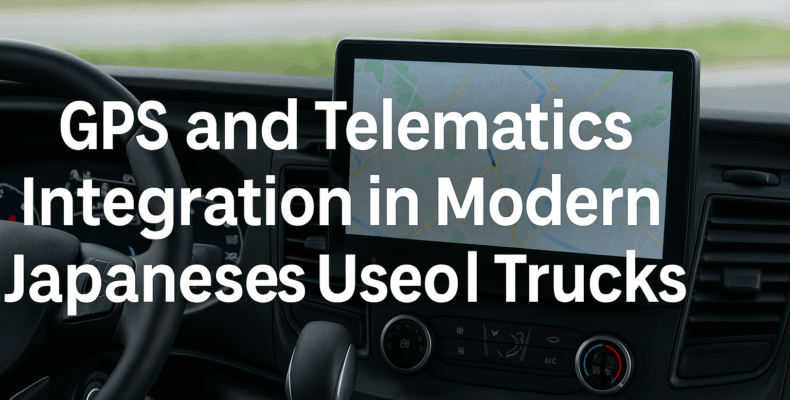Modern Japanese used trucks are no longer just mechanical workhorses—they are smart, connected, and highly efficient. Thanks to GPS and telematics integration, operators can now track vehicles, improve fuel economy, and increase safety with ease.
From single-unit drivers to full-scale fleet managers, understanding the value of these features is essential. Japanese trucks like the Isuzu ELF, Hino Dutro, and Fuso Canter are widely available with GPS capabilities and support easy telematics upgrades.
Let’s break down what GPS and telematics systems offer and how they improve truck operations for global buyers.
🚚 What Is Telematics in Japanese Trucks?
Telematics is the use of digital systems to gather, transmit, and analyze truck data. When combined with GPS, it enables real-time insights into:
-
Vehicle location
-
Speed and route history
-
Fuel usage
-
Driving behavior
-
Engine condition and alerts
This information is often sent to cloud dashboards or mobile apps, allowing owners and managers to make smart decisions quickly.
✅ Key Benefits of GPS and Telematics Systems
1. Real-Time Vehicle Tracking
First, GPS lets you know exactly where your truck is, 24/7.
This is especially helpful when managing multiple units across countries or regions.
-
See current location and direction
-
Track delivery progress and ETA
-
Prevent unauthorized vehicle use
Moreover, it increases customer trust when updates are shared live.
2. Route Optimization and Fuel Efficiency
By analyzing past routes and current traffic, you can shorten travel time.
This reduces fuel costs and wear on the vehicle.
-
Identify high-idle or stop-start zones
-
Avoid congested roads
-
Compare route efficiency by trip
In countries where diesel is expensive, this feature pays off fast.
3. Driver Safety and Behavior Monitoring
Many systems can detect sudden acceleration, sharp turns, or hard braking.
-
Receive alerts for unsafe driving habits
-
Coach drivers with feedback
-
Reduce accident rates and downtime
Over time, this leads to safer operations and fewer insurance claims.
4. Maintenance Scheduling and Alerts
Sensors monitor engine health, oil levels, and brake wear.
-
Get notifications before failures happen
-
Schedule timely maintenance
-
Avoid unexpected roadside breakdowns
This is especially useful for trucks with high mileage or older components.
5. Geofencing and Compliance
Geofencing lets you create virtual zones on a map.
When a truck enters or exits the zone, you get an alert.
-
Useful for customs areas or secure delivery sites
-
Supports government regulations in some countries
-
Helps track border-crossing and port activity
📦 Popular Japanese Trucks Supporting GPS and Telematics
| Truck Model | Integrated Telematics Options |
|---|---|
| Isuzu ELF (N-Series) | Isuzu Connect, supports fleet tracking |
| Hino Dutro | Hino Connect and 3rd-party GPS compatible |
| Fuso Canter | Truckonnect telematics and smart dashcam |
| Toyota Dyna | GPS-ready in newer export variants |
If the truck you buy doesn’t have these systems, many exporters can install GPS devices before shipping.
🌍 Why Global Buyers Should Care
Across Africa, Southeast Asia, the Middle East, and South America, businesses are scaling logistics. Managing trucks from a distance requires data. GPS and telematics provide that data in real time.
-
Monitor fleets across countries
-
Avoid fuel theft or misuse
-
Improve delivery schedules and coordination
Even for personal users, telematics helps reduce ownership costs.
🧭 Tips Before You Buy
-
Ask for recent GPS system compatibility in the truck spec sheet
-
Request photos of dashboard or screens
-
Check if SIM-based or satellite telematics is used
-
Choose exporters who offer optional telematics installation
👉 Start your search with trusted suppliers here:
Top 5 Trusted Japanese Used Truck Exporters for Global Buyers
These exporters can advise you on available models, custom upgrades, and legal compliance in your country.
✅ Final Thoughts
The future of trucking is connected. GPS and telematics make Japanese used trucks not only reliable but also intelligent. They help you stay safe, reduce costs, and grow your business with confidence.
If you’re planning your next import, don’t just look under the hood—look at the tech behind the wheel.
